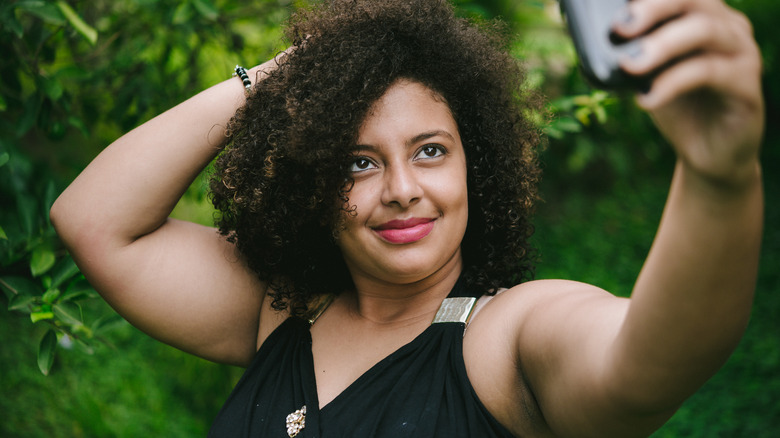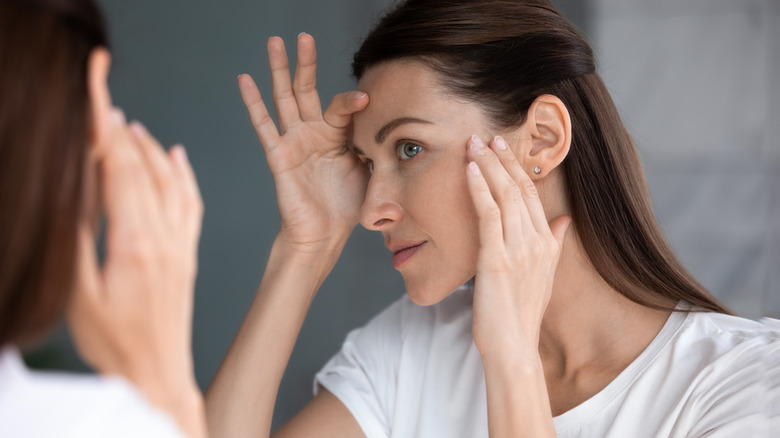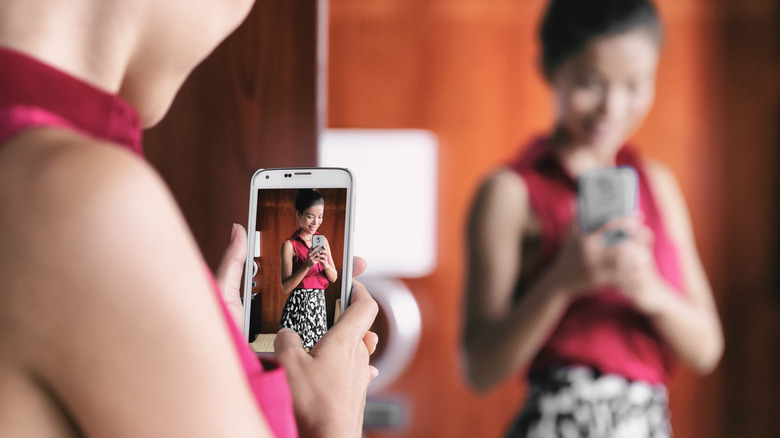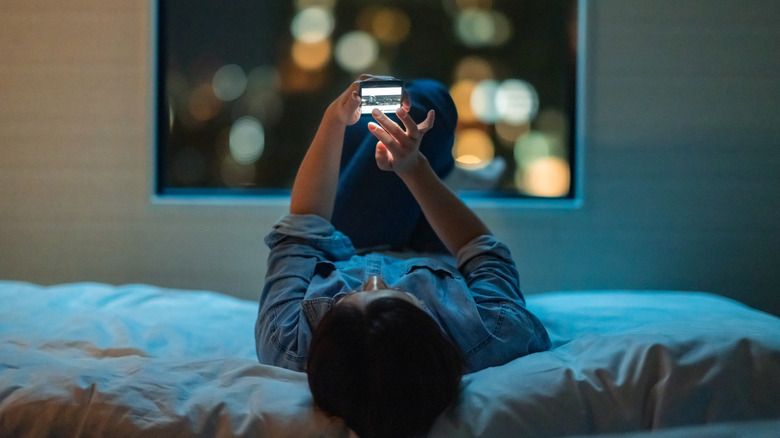How To Deal With Body Dysmorphia In The Age Of Social Media, According To A Psychologist
We may receive a commission on purchases made from links.
Social media is an almost inescapable part of modern life. Unplugging from the internet doesn't offer much reprieve, as you'll still spot influencers on magazines and billboards throughout the day. For many, the pervasiveness of social media can be easily overlooked, but for those with body dysmorphic disorder, the superficial slant of social media and influencer culture may take a toll on their overall mental health.
Maybe you've heard about body dysmorphic disorder, also known as BDD, or perhaps you or a loved one struggle with dysmorphic thoughts. The effects of body dysmorphia extend beyond low self-esteem, severely impacting one's quality of life. Navigating the world with BDD has never been easy, but social media can present increased challenges for affected individuals. According to research published in The Psychology of Popular Media, cutting back on social media usage can significantly improve self-esteem and body image in teens and young adults.
Of course, those living with body dysmorphia may feel stuck between a rock and a hard place, finding it difficult to engage in online spaces without exacerbating negative thoughts or behaviors. Glam spoke exclusively to Dr. Talia Wiesel, cognitive psychologist and clinical assistant professor of psychology at Weill Cornell Medical College, to learn more about coping with body dysmorphia in the age of social media.
What is body dysmorphia?
While body dysmorphia is slowly gaining more recognition, many remain confused about what it really is. So, what exactly is body dysmorphic disorder? According to Dr. Talia Wiesel, it's more complex than you might think. Roughly 40% of those with BDD are men, she says, and the condition can affect people of all ages. "People with BDD perceive themselves as looking ugly, abnormal, or disfigured when in reality, they look normal," Dr. Wiesel exclusively tells Glam. "People with BDD perform repetitive behaviors — i.e., 'rituals' and 'compulsions' – in response to their distress regarding their appearance."
For many people with BDD, even routine social activities can trigger these ritualistic or compulsive behaviors. You might think your friend is overdramatic when they complain about their looks after taking a group photo, but they may be struggling to hold back their dysmorphic thoughts. "The rituals — like comparing disliked body parts with others or checking disliked body areas in mirrors or taking selfies — are often difficult to resist or control," Dr. Wiesel explains. Everyone's experience with body dysmorphia is slightly different, but some common rituals include body checking, hiding perceived flaws with makeup or accessories, and talking negatively about their body. The experience of living with untreated body dysmorphia can lead to anxiety, isolation, and depression, and in some cases, social media usage can intensify these negative feelings.
How social media impacts body dysmorphia
Body dysmorphia might be a hot topic in current conversations on mental health, but it's far from new. According to research published in the medical journal American Family Physician, dysmorphia was first identified by Italian physician Enrique Morselli in 1891, though BDD wasn't classified as a disorder by The American Psychiatric Association until 1987. As such, many public figures, from Sylvia Plath to Michael Jackson, are thought to have struggled with BDD prior to the APA's official recognition of it.
Dr. Talia Wiesel points out that body dysmorphia can develop due to numerous factors, from genetic predisposition and personality traits to "life experiences – like a history of bullying or abuse." In the face of social media, however, those with BDD may face unique challenges. "BDD has been and continues to be underrecognized and undertreated. Social media may not cause BDD, but it can worsen the condition," Dr. Wiesel exclusively tells us. "Social media exposure can worsen body image dissatisfaction and comorbidities of BDD, like depression and eating disorders."
Whereas past generations may have compared themselves to stars on film or in print, social media makes it easier than ever for those with BDD to engage in near-constant comparison with others from all walks of life. What's more, dysmorphia can hold people back socially and occupationally as self-promotion becomes increasingly high-stakes online. Even if your ambitions don't involve becoming an influencer, you may still dread routine tasks like attending video meetings or selecting a headshot for social network platforms.
Can cosmetic treatments help those with dysmorphia?
With the widespread usage of cosmetic enhancements like fillers & surgery plainly visible across social media, it can be tempting for those with BDD to explore aesthetic interventions to relieve their symptoms. Yet, according to Dr. Talia Wiesel, these procedures can have unintended effects on those with BDD. "Many people with BDD believe that if they get cosmetic treatment, it will change how they feel about their appearance. However, cosmetic treatment is not recommended for BDD. It is almost never helpful and can make BDD symptoms worse," Dr. Wiesel exclusively explains to Glam. "Furthermore, certain features are trendy, transient fads — such as sculpted high cheekbones or full, lush lips. The majority of patients (75%) often regret these procedures, and while some are reversible, like lip fillers, others are permanent, like buccal fat removal."
To make matters worse, social media has led to the emergence of countless new insecurities, often inspired by body-checking behaviors disguised as trends. On TikTok, users look for feedback on the profiles of their noses or outlines of their limbs, while Redditors engage in heated discussions over which physical traits are closest to perfection. "Excessive social media use can increase preoccupation with imagined defects among people with BDD leading them to pursue minimally invasive cosmetic and plastic surgery procedures," says Dr. Wiesel. "Celebrity plastic surgeons have a strong social media presence, posting videos of cosmetic procedures and before-and-after photos, which receive hundreds of thousands of views and likes."
Ways to deal with body dysmorphia effectively
Trying to manage body dysmorphia in a culture obsessed with social media can feel like an uphill battle, but fortunately, treatment is available. Whether you've struggled with dysmorphic thoughts for as long as you can remember or are just beginning to spot symptoms, there are clinically proven strategies that Dr. Talia Wiesel suggests trying first. "Selective serotonin reuptake inhibitors — high doses are often needed – is the first-line medication treatment," she exclusively tells Glam. Common SSRI medications include Prozac, Zoloft, Effexor, and Lexapro, and they can help ease the recurrent negative thoughts associated with body dysmorphic disorder and are available by prescription only. To find out more, speak to a trusted healthcare professional like your primary care provider or therapist, who can help select the best treatment for you.
From there, Dr. Wiesel recommends seeking cognitive-behavioral therapy, also known as CBT. Directories like Psychology Today can help you find a local mental health professional who specializes in CBT, but there are several at-home interventions you can use as well. Dr. Wiesel suggests reading "Feeling Good about the Way You Look" by Sabine Wilhelm, Ph.D., and "The Broken Mirror: Understanding and Treating Body Dysmorphic Disorder" by Dr. Katharine Phillips. In addition to self-help books, those with BDD can explore online resources like The Body Dysmorphic Disorder Foundation and The International OCD Foundation. Though body dysmorphia is not the same as obsessive-compulsive disorder, research published in The Journal of Clinical Psychiatry suggests that the conditions have some similarities.
Overcoming your fear of posting on social media
The fear of rejection, ostracization, or abusive comments can lead many people with BDD to avoid posting anything on social media. Moreover, opening an app like Instagram and viewing others' posts can inspire anxiety in those with BDD due to social comparison and insecurity.
So, is it better to fight your fears and join in with other posters, or should you walk away from social media altogether if you have persistent dysmorphic thoughts? Well, that depends on where you are on your journey. "Most people with BDD struggle to take pictures, let alone post them online. I often recommend taking a break from social media if it is being used in an unhealthy way, like scrutinizing others and comparing themselves with friends or celebrities," Dr. Talia Wiesel tells Glam in our exclusive chat.
Nevertheless, taking a step back from social media doesn't have to be permanent. "As patients begin to improve and learn coping strategies to manage their BDD, we gradually start to confront anxiety-provoking situations that are difficult or avoided, like taking unfiltered pictures with others, and eventually, posting these pictures on social media," Dr. Wiesel tells Glam. The pressure to appear perfect — especially online, where filters run rampant — can feel overwhelming for those with body dysmorphia. That said, the era of airbrushed perfection may be coming to an end. An increasing number of individuals, influencers included, have recently shifted their focus toward producing authentic content that unabashedly depicts their flaws.
Using social media positively with BDD
For all its faults, social media shows some promise in the fight against body dysmorphia. "Social media can help raise awareness about BDD and its treatment," Dr. Talia Wiesel exclusively tells Glam. "Celebrities have begun to discuss their struggles with BDD, like Robert Pattinson, Demi Lovato, and more recently, Meghan Fox. It can be helpful knowing people who are known for their beauty believe they struggle with BDD and aren't perceiving themselves accurately." Although no one's path is quite the same, it's important to understand you aren't alone in combating dysmorphia.
Ultimately, it's up to the individual to decide how to best interact with social media. As Dr. Wiesel points out, patients in earlier phases of treatment may need to take a break from online spaces before challenging themselves by sharing more. Above all, those struggling with body dysmorphia should know that healing can take time, but change is possible. Pursuing cognitive-behavioral therapy, challenging negative thoughts, and finding safe spaces in life and online are all steps in the right direction.






